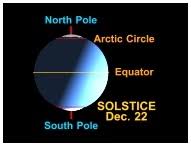Winter Solstice : December 22

India prepares for the longest night of the year on December 22, a phenomenon known as the Winter Solstice.
- The winter solstice marks the shortest day of the year.
- The Earth is tilted 23.4 degrees on its axis, so if the Earth’s pole is pointing towards or away from the Sun during the day, the arc the Sun travels through will rise and fall during the year.
- Winter Solstice happens when one of the Earth’s poles is far away from the Sun.
- It falls on December 21 or 22 in the Northern Hemisphere and June 20 or 21 in the Southern Hemisphere.
- The word solstice is derived from the Latin word solstitium, where ‘sol’ means Sun and ‘stitium’ means to stop.
- During the winter solstice, the days are the shortest.
- The duration of daylight will vary across countries.
- The winter solstice is significant in many cultures since it marks the symbolic death and rebirth of the Sun.
- Ancient monuments like Stonehenge are aligned with the sunrise or sunset on the winter solstice.
- December’s winter solstice is when the northern half of the Earth is tilted furthest away from the sun.
- The northern hemisphere will experience the fewest hours of sunlight, making it the shortest day of the year while the night is the longest.
- Every day after the winter solstice will grow longer in the northern hemisphere until it’s summer solstice, or the longest day of the year, between June 20 and 22.




